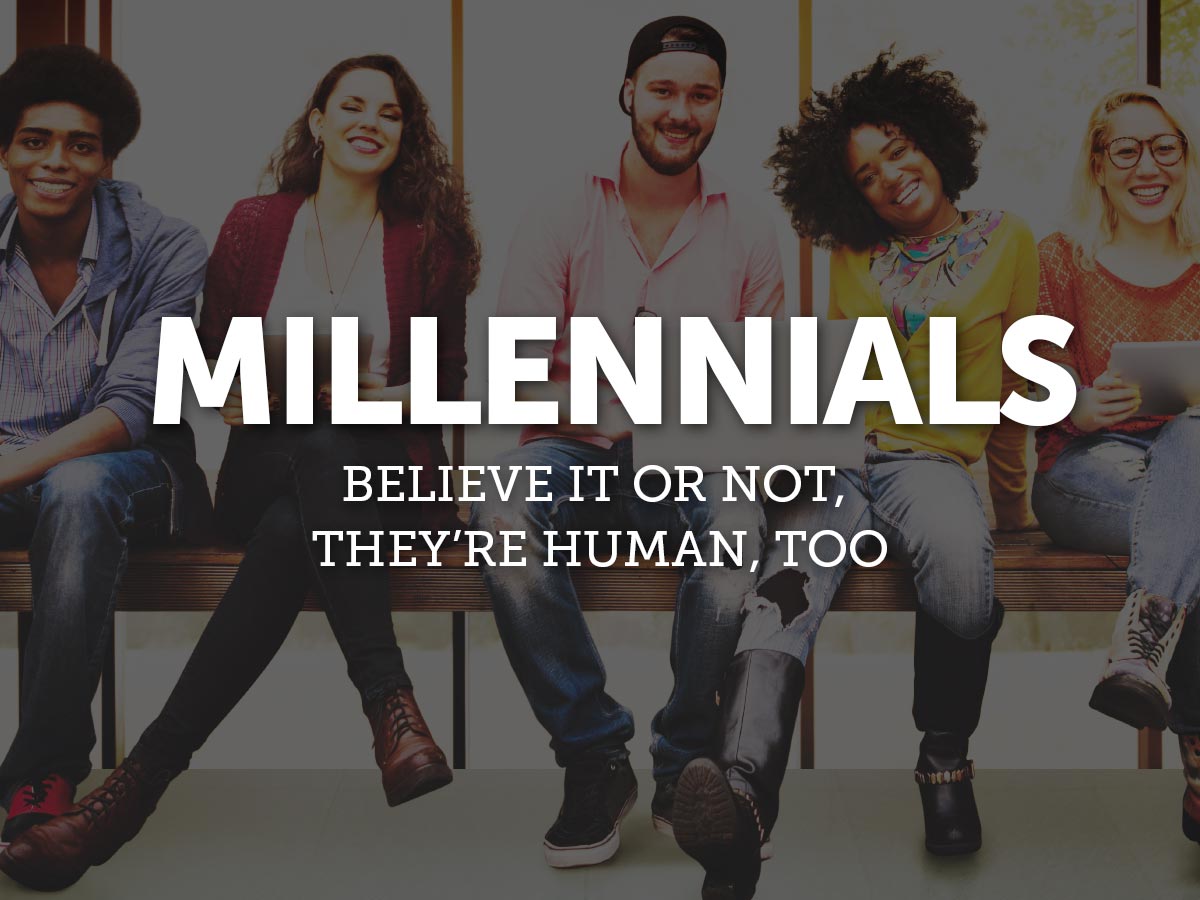But I’m at the tail end of Generation X, so I feel a close connection with those right behind me, the all-important millennial generation.
In fact, some of my best friends are millennials, so I know that while stereotypes about them may apply, they’re not 100% accurate all the time. Sure, millennials have a lot of qualities that make marketing to them unique. But in many ways, they’re just like the rest of us. Here’s how:
They’re young … and we were young once, too!
When you were in the 18–34 age range, brands wanted to reach you, too. (Unless those brands were selling Depends, of course.)
Why? Because the youngest generation is always seen as hip. They’re the trendsetters and are often the first to embrace and drive technological change, no matter what the year is. They frequently have disposable income, whether it’s their parents’ money or their own.
But millennials have access to way more information than previous generations. They can research their prospective purchases in a way that wasn’t possible a generation ago. That’s a prime opportunity for content marketers to provide information to help drive millennials’ decision-making.
They use smartphones … but so does everyone else!
No doubt, millennials born between 1980 and 2000 are digital natives, and that has presented a conundrum for traditional marketers looking to reach them.
Mobile technology has enabled this generation to do things their parents never imagined, like watching a movie on their phone. But mobile technology and social media are not just the domain of millennials. We’re all online, and more often, and it’s changing the way we all communicate, learn, shop and experience entertainment. That is a broader challenge for marketers that requires refined targeting efforts to reach prospective consumers.
And, remember, while millennials may be among the first to embrace the most recent technological changes, other generations embraced television, cable, the Walkman, CDs and email. And marketers adapted accordingly. It just requires agile, creative thinking.
They use social media … but so does your grandma!
Millennials lead the way in using social media, but they’re not the only ones using it. About two-thirds of American adults use Facebook, and the number of us on Pinterest and Instagram has doubled in the last three years. If you’re selling something and not thinking about engaging on social media with your target audience, your brand will go the way of the dinosaur.
People of all ages use social media to connect with each other, to be entertained, to learn and to gather information about products and services. (How often have you asked your Facebook friends for advice on a purchase?)
For content marketers, the opportunity to share stories through social media is limitless, whether people are actively seeking out the information or stumble on it. Providing information about products—while also telling a powerful brand story and engaging with your audience on social media— is a crucial component of content marketing. Scroll through any of your social media accounts and try not to be tempted to buy something or learn more about a product or service.
We’re all embracing communicating through social media, but it’s important to note that each generation uses it in vastly different ways. Your grandma is doing it differently than your teenage niece—that is, if your niece is even on Facebook anymore.
While Facebook is still popular among millennials, the average millennial uses four social networks. They’re also more apt to use apps like Snapchat and Instagram than older generations.
For content marketers, this means tailoring your message and using the social media networks your target demographic uses. Just be sure to communicate authentically. For example, you wouldn’t want to post something with a lot of text on Instagram; instead, you’d want to choose a visual that speaks for itself. And remember, the social media networks where you need to target your message can vary greatly, even when the age difference is relatively small. Just take a look at these takes on social media by a 19-year-old and a 13-year-old and how they use social media in totally different ways.
Research where to focus your message on social media, but use analytics, as well, to get specific details on whether your message is resonating on social media.
They’re human … just like the rest of us!
Millennials are going to hit the same milestones every generation does: careers, love, marriage, kids and home ownership.
However, with the Great Recession of 2008, many millennials are moving on later than previous generations because they’ve lacked the financial ability to do so.
In many ways, that gives marketers an edge. No matter how much things change, some things stay the same. New parents are going to want the best for their child. After years of renting, many of us start to dream about buying our own home. We start to think about saving money.
Marketers can capitalize on these universal themes of life, because millennials are finally starting to catch up. For example, the millennial generation is now hitting its prime parenting years. A whopping 90 percent of new moms in 2014 were millennials and 2015 is the first year where more millennials are parents than not.
When I was pregnant two years ago, I thought Subaru was targeting its ads directly to me, and this ad still really gets to me especially as a former Forester owner. Kids, dogs, keeping your kids safe, watching them grow up—in many ways the message is the same as it was for previous generations. The trick here is to be authentic and, again, know where your audience is spending its time. Millennials are going to be on social media, and content marketing can be used as a vehicle to provide substance behind the message.
They care … but so does everyone else!
Any major generational shift is going to have ripple effects and this will require changes in how brands market themselves.
Millennials are bringing about a positive change by supporting brands that give back and position themselves as being about more than profits.
Millennials want to feel good about what they buy, but don’t we all? For millennials, brand loyalty is earned. Millennials like to belong and want to be part of the conversation. A recent survey found that many millennials would actually like to help co-create products with companies, suggesting they want a real connection with the products they buy.
This is a generation that’s seen the impact of corporate greed and they have a big megaphone—social media—that was not available a generation ago, to share their support of brands and products.
Brands can embrace this and not only increase their millennial customer base, but their overall customer base.
SoapBox Soaps, founded in 2010, is a good example of this. For every product purchased, the company provides a bar of soap or clean water to a person in need in the U.S. or abroad. Each product also has a Hope Code you can enter on their website to look up how exactly your purchase will help someone.
From a marketing standpoint, the Hope Code not only highlights the company’s products and mission, but it’s also an opportunity to engage consumers further by getting them to their website.
The company blog offers a range of posts—on philanthropic efforts, new partnerships with grocery stores and even information about the products themselves. The website offers additional opportunities to connect with the brand, with information about creating fundraisers with the products and how to connect with them on social media. While the company appears to be in its infancy on some of its marketing efforts, the overall message is clear: if you buy our products, you can help change the world.
And that’s a message that resonates with everyone, not just millennials.



